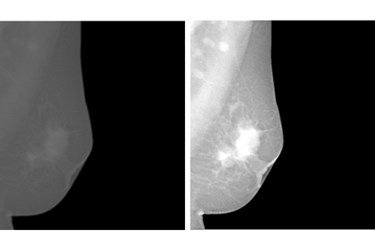New Imaging System Could Predict Breast Cancer Risk, Reduce Need For Mammograms

A new computer-aided detection system can accurately predict if and when a woman is likely to develop breast cancer. Researchers say the technology could reduce the number of mammograms performed each year and cut down on unnecessary risks that some experts say are caused by annual exams.
The program, designed by a team from the University of Texas, El Paso (UTEP), analyzes images from standard mammogram x-rays and scans them for certain telling features that can be indicative of elevated breast cancer risk. According to a UTEP press release, these features include the texture and density of breast tissue, areas of especially dense tissue, and significant differences between the right and left breasts.
Research shows that women with highly dense breast tissue are five times more likely to develop breast cancer than women with low densities, and a loss of balance between the two breasts can signify a potentially problematic change.
A study published by UTEP researchers and collaborators in Computerized Medical Imaging and Graphics reported that the system was 70 percent accurate in predicting which women would develop breast cancer within the next year and those who would not.
Wei Qian, head of UTEP’s Medical Imaging Informatics Lab, says that the program could potentially predict the onset of breast cancer a few years in advance. Qian said doctors could use this information to decide how aggressively to screen each individual patient. Women at high risk could be screened more aggressively, while women with low risk could be advised to undergo fewer mammograms.
“For low risk populations, it would be better to increase the interval between their screenings,” said Wenqing Sun, a Ph.D. candidate at UTEP. “Mammograms frequently generate false positives and can be an unnecessary mental burden.”
This week, the U.S. Preventative Services Task Force (USPSTF) released a report that advised both women and healthcare professionals to reconsider if an annual mammogram was necessary for every patient every year, citing risk of overdiagnosis, false positives, radiation exposure, undue financial burden, and psychological strain.
According to the task force, mammograms are most beneficial for women between the ages of 50 and 74. In the USPSTF’s controversial 2009 guidelines, the panel did not recommend mammograms for women under 50, but in their revised opinion, they suggest that women ages 40 to 49 should decide for themselves if the test is right for them.
Kristen Bibbins-Domingo, a professor of Medicine at the University of California, San Francisco (UCSF) and vice chairman of the task force, told the Wall Street Journal, “There is value to mammography screening in the 40s. There are benefits, and they exceed the harms but only by a small amount.”
Other experts are skeptical, and say that women in their 40s are still at risk and should take every available precaution. The CDC estimates that over 40,000 women die every year from breast cancer, making it the most common cause of cancer death in women.
Richard Wender, chief cancer control officer of the American Cancer Society told the WSJ, “Seventeen percent of women who go on to die of breast cancer were diagnosed in their 40s. Nobody knows what the real overdiagnosis rate is.”
Image credit: UTEP Medical Imaging Informatics Lab
